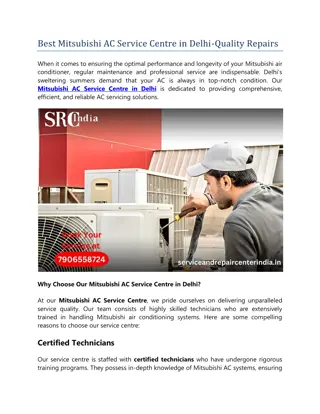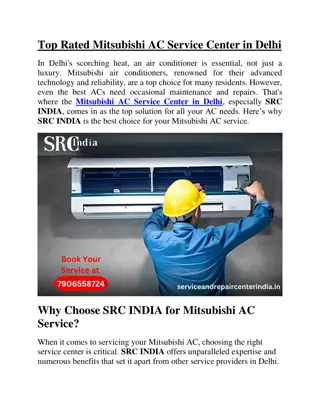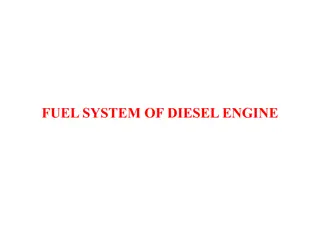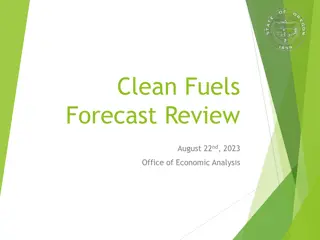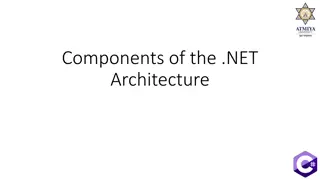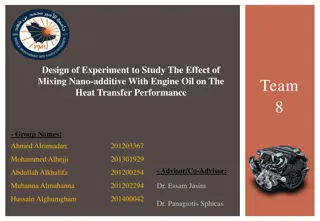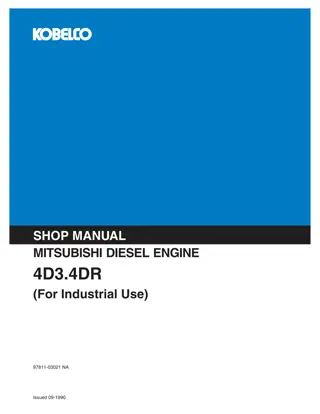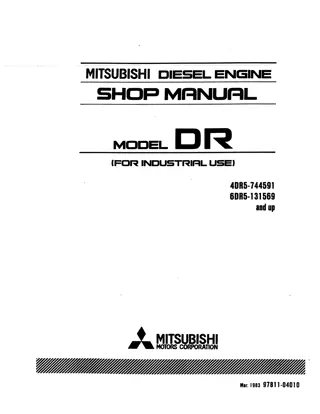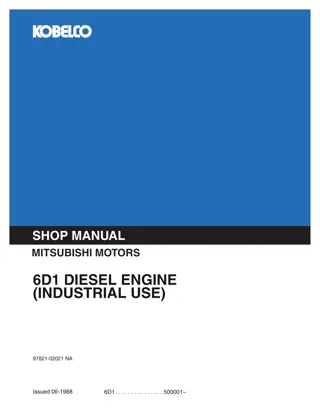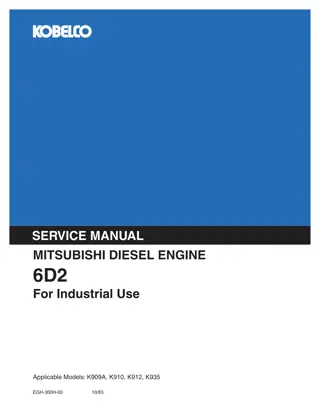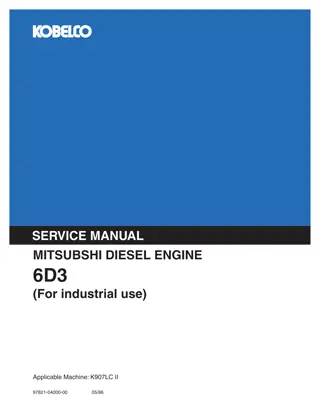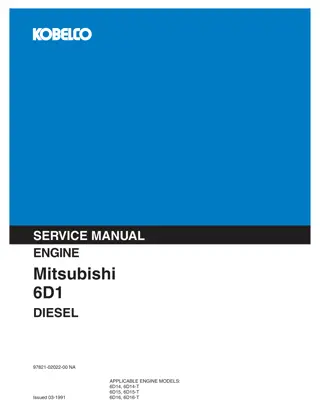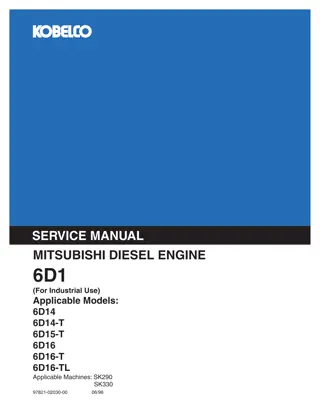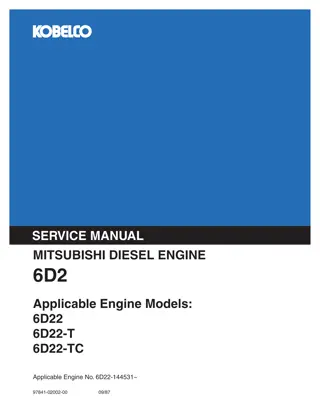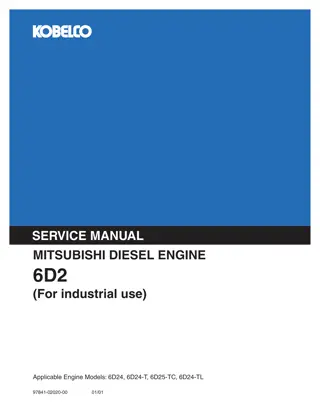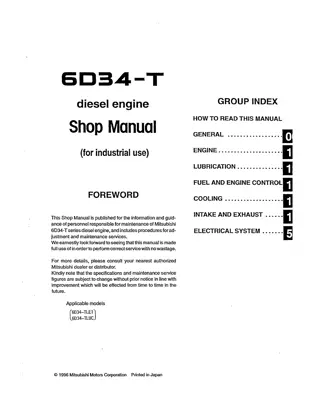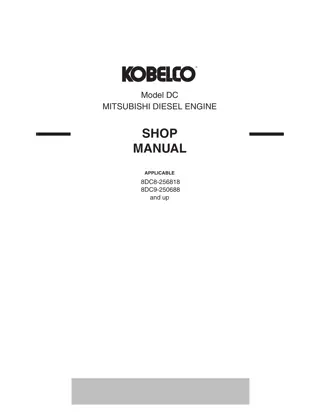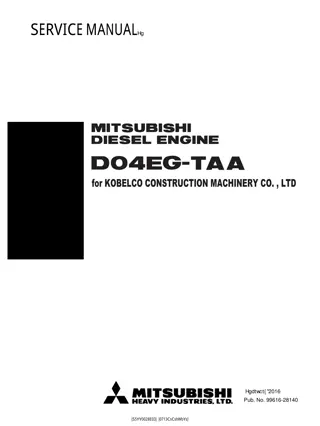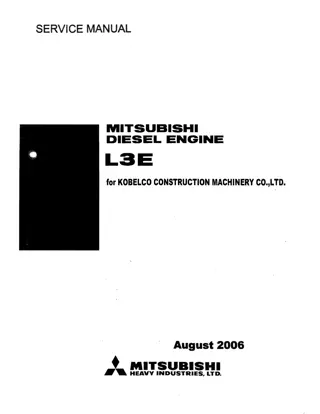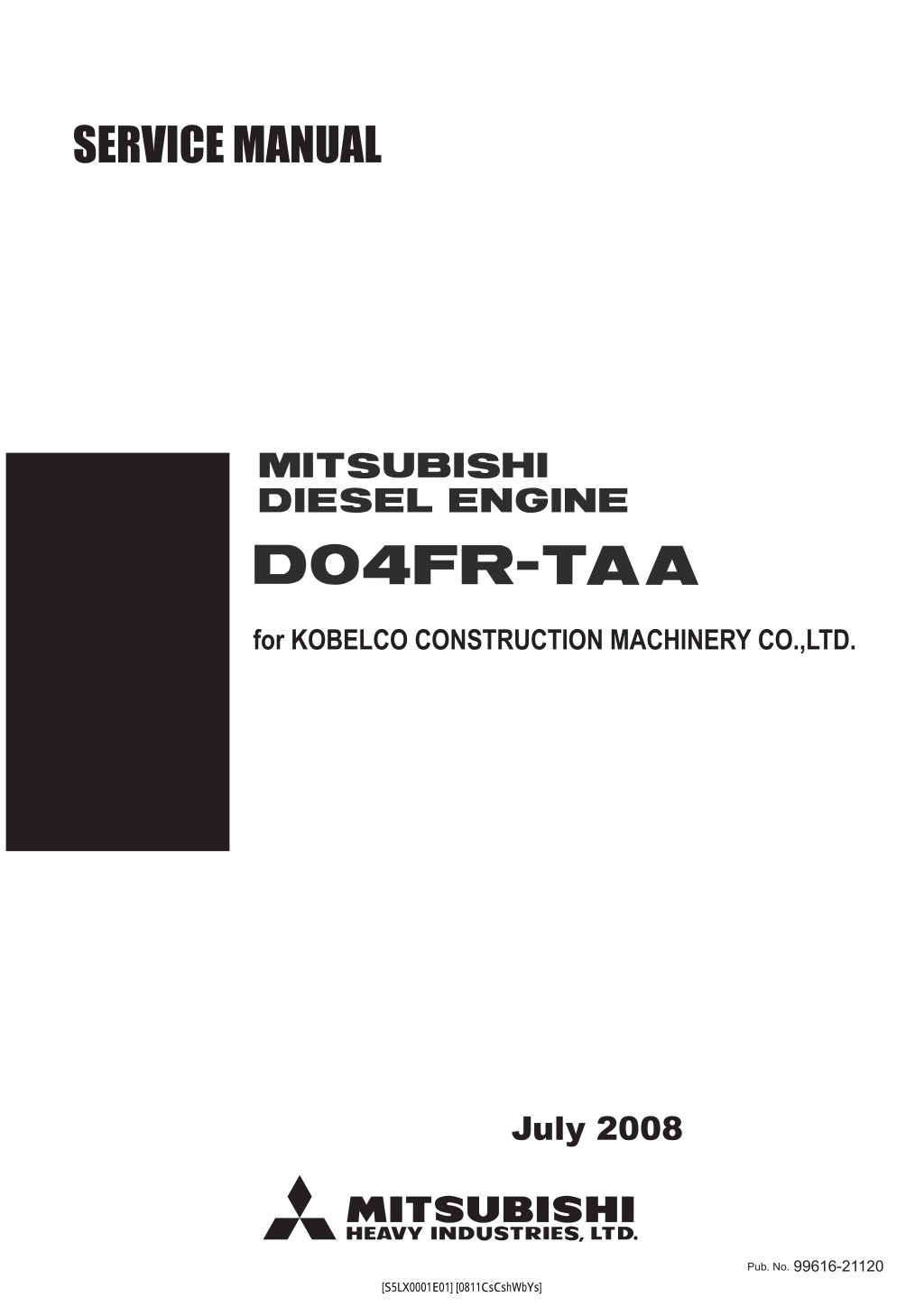
Kobelco Mitsubishi D04FR-TAA DIESEL ENGINE Service Repair Manual Instant Download (Book Code No. 99616-21120)
Please open the website below to get the complete manualnn//
Download Presentation

Please find below an Image/Link to download the presentation.
The content on the website is provided AS IS for your information and personal use only. It may not be sold, licensed, or shared on other websites without obtaining consent from the author. Download presentation by click this link. If you encounter any issues during the download, it is possible that the publisher has removed the file from their server.
E N D
Presentation Transcript
INTRODUCTION This service manual describes the specifications, maintenance and service procedures for Mitsubishi diesel engines. To maintain the performance of the engine for many years and to ensure safe operation, it is important to use the engine correctly and conduct regular inspection and maintenance, and also to take necessary measures which involves the disassembly, inspection, repair and reassembly of the engine and engine parts. Read this manual carefully and understand the work procedures fully before disassembling, inspecting, repairing or reassembling the engine. The contents of the manual are based on the engine models that are being produced at the time of publication. Due to improvements made thereafter, the actual engine that you work on may differ partially from the one described in this manual. Pub.No.99616-21120 [S5LX0001E01] [0811CsCshWbYs]
INTRODUCTION How to use this manual This service manual consists of several Groups, which are arranged so as to allow you to make reference quickly to specifications, maintenance standards, adjustment procedures and service procedures including methods for disassembly, inspection, repair and reassembly of the Mitsubishi Diesel Engine (standard model for land use). A short summary describing the content of each Group is given in the General Contents page, and there is also a detailed table of contents at the beginning of each Group. Regarding the procedures for operation and periodical maintenance of the engine, refer to the Operation and Maintenance Manual. For information on the engine components and ordering of service parts, refer to the Parts Catalogue. Structure and function of the engine are described in the relevant training manuals. Methods of presentation (1) Index numbers allotted to parts in exploded views are not only a call-out of part names listed in the text but also an indi- cation of the sequence of disassembly. (2) Inspections to be conducted during disassembly process are indicated in boxes in the relevant exploded views. (3) Maintenance standards required for inspection and repair works are indicated in the appropriate positions in the text. They are also collectively indicated in Group 2, the General Contents group. (4) Fasteners to be tightened in wet condition, or with engine oil applied, are identified by [Wet] placed after tightening torque values. If no such indication is suffixed, the fastener should be tightened in dry condition, or without lubricating with engine oil. (5) In this manual, important safety or other cautionary instructions are emphasized with the following marks headed. DANGER Indicates an immediately hazardous situation which, if not avoided, will result in death or serious injury. WARNING Indicates a potentially hazardous situation which, if not avoided, could result in death or serious injury. CAUTION Indicates an immediately hazardous situation which, if not avoided, may result in minor or moderate injury. CAUTION Indicates a potentially hazardous situation which, if not avoided, can result in property damage. ? ? ? ? ? Emphasizes important matter, or indicates information useful for operation or maintenance of the engine. I [S5LX0001E01] [0811CsCshWbYs]
https://www.ebooklibonline.com Hello dear friend! Thank you very much for reading. Enter the link into your browser. The full manual is available for immediate download. https://www.ebooklibonline.com
INTRODUCTION Terms used in this manual Nominal means the rated (design) size or magnitude of a part to be measured. Standard means the quantitative requirement for dimension of a part, clearance between parts and performance. This is given in a form of tolerance. Therefore, the values shown are not in agreement with the design values. Limit means that, if this value is reached, the part must be repaired or replaced with a new part. Abbreviations BTDC: Before Top Dead Center ATDC: After Top Dead Center BBDC: Before Bottom Dead Center ABDC: After Bottom Dead Center TIR: Total Indicated Runout API: American Petroleum Institute ASTM: American Society for Testing and Materials JIS: Japanese Industrial Standards LLC: Long Life Coolant MIL: Military Specifications and Standards (U.S.A) MSDS: Material Safety Data Sheet SAE: Society of Automotive Engineers (U.S.A) Units of measurement Measurements are based on the International System of Units (SI), and their converted metric values are indicated in parentheses {}. For metric conversion, the following rates are used. Pressure: 1 MPa 10.197 kgf/cm Torque: 1 N m 0.10197 kgf m Force: 1 N = 0.10197 kgf Horsepower: 1 kW = 1.341 HP = 1.3596 PS Meter of mercury: 1 kPa = 0.7 cmHg Meter of water: 1 kPa 10.197 cmH2O (cmAq) Rotational speed: 1min-1 1 rpm II [S5LX0001E01] [0811CsCshWbYs]
INTRODUCTION Safety Cautions WARNING Fire and explosion Keep flames away Store fuel and engine oil in a well ventilated designated area. Make sure that the caps of fuel and engine oil containers are tightly closed. Do not use flames, do not smoke, and do not work near a heater or other fire hazard where fuel or oil is handled or when cleaning solvent is being used for washing parts. Wipe off spilled fuel, oil and LLC immediately and thor- oughly. Spilled fuel, oil and LLC may ignite and cause a fire. Care about fuel, oil and exhaust gas leakage If any fuel, oil or exhaust gas leakage is found, immedi- ately take corrective measures to stop it. Such leakages, if left uncorrected, can cause fuel or engine oil to reach hot engine surfaces or hot exhaust gas to contact flammable materials, possibly leading to personal injury and/or damage to equipment. Use explosion-proof lighting apparatus When inspecting fuel, engine oil, coolant, battery elec- trolyte, etc., use a flameproof light. An ordinary light, if accidentally broken, may ignite and cause an explo- sion. Prevent electrical wires from short-circuit- ing Avoid inspecting or servicing the electrical system with the ground cable connected to the battery. Otherwise, a fire could result from short-circuiting. Be sure to dis- connect the battery cable from the negative (-) terminal before beginning with the work procedure. Short-circuits, possibly resulting in fire, may be caused by a loose terminal or damaged cable/wire. Inspect the terminals, cables and wires, and repair or replace the faulty parts before beginning with the service proce- dure. Keep surrounding area tidy and clean Do not leave combustible or explosive materials, such as fuel, engine oil and LLC, near the engine. Such sub- stances can cause fire or explosion. Remove dust, dirt and other foreign materials accumu- lated on the engine and surrounding parts thoroughly. Such materials can cause fire or the engine to over- heat. In particular, clean the top surface of the battery thoroughly. Dust can cause a short-circuit. Always operate the engine at a position at least 1 m [3.28 ft.] away from buildings and other equipment to prevent possible fire caused by engine heat. Keep fire extinguishers and first-aid kit handy Keep fire extinguishers handy, and become familiar with their usage. Keep a first-aid kit at the designated place where it is easily accessible by anyone at any time. Establish response procedures to follow in the event of fire or accident. Provide an emer- gency evacuation route, contact points, and means of communication in case of emergency. III [S5LX0001E01] [0811CsCshWbYs]
INTRODUCTION WARNING Stay clear of all rotating and moving parts Install protective covers on rotating parts Make sure the protective covers for engine rotating parts are properly installed as intended. Repair loose or damaged protective covers as necessary. Never remove the covers guarding personnel from rotating parts, when the engine is oper- ating. When combining the engine with the engine-driven ma- chine or radiator, always provide a cover on every ex- posed moving part such as driving belt and coupling. Never remove protective covers. Lockout and Tagout Be sure to lockout and tagout before starting inspection and maintenance. Lockout and tagout are effective methods of cutting off machines and equipment from energy sources. To accomplish the lockout/tagout, remove the starter switch key, set the battery switch to OFF and attach a "Do Not Run" or similar caution tag to the starter switch. The starter switch key must be kept by the person who performs inspection and maintenance during the work. In the case of pneumatic starting type, close the main valve of the air tank and post a tag saying "Do Not Open the Valve" or the like. Ensure safety of neighboring people before starting engine Before starting the engine, ensure that there is nobody in the neighborhood and that no tools are left on or near the engine. Verbally notify people around the engine or in the work area when starting the engine. When the starter device is posted with a sign that pro- hibits startup operation, do not operate the engine. Keep engine stopped during servicing Be sure to stop the engine before proceeding to inspec- tion and service procedure. Never attempt to make ad- justments on the engine parts while the engine is running. Rotating parts such as belt can entangle your body and cause serious injuries. Always restore engine turning tools after use Do not forget to remove the tools which have been used for turning the engine during inspection or servic- ing, after the procedure is finished. Remember also that the turning gear must be returned to the operating condition before starting the engine. Starting the engine with the turning tools inserted or with the turning gear in engagement can lead to not only engine damage but also personal injuries. Stay clear of moving parts during engine running Do not approach rotating or sliding parts of the engine when the engine is in operation. Keep objects likely to be caught by rotating parts away from such parts. If any part of the clothing or outfit- ting is caught by a rotating part, se- rious bodily injuries could result. IV [S5LX0001E01] [0811CsCshWbYs]
INTRODUCTION WARNING WARNING Be careful of burns Protect ears from noises Do not touch the engine during or immedi- ately after operation Do not touch the engine during or immediately after operation to avoid risk of burns. To conduct maintenance and in- spection work, wait until the engine has cooled sufficiently, checking the temperature gauge. Wear ear plugs Always wear ear plugs when enter- ing the machine room (engine room). Combustion sound and me- chanical noise generated by the en- gine can cause hearing problems. Slowly and carefully open radiator cap Never attempt to open the radiator cap while the engine is running or immediately after the engine stops. Give a sufficient cooling time to the engine coolant before opening the cap. When opening the radiator cap, slowly turn the cap to release internal pressure. To prevent scalds with steam gushing out, wear thick rubber gloves or cover the cap with a cloth. Close the radiator cap tightly without fail. The coolant is very hot and under pressure during en- gine running or just after the engine stops. If the radia- tor cap is not closed tightly, steam and hot coolant may gush out and can cause scalds. Add coolant only after the coolant tempera- ture dropped Do not add coolant immediately after the engine stops. Wait until the coolant temperature lowers sufficiently to avoid a risk of burns. V [S5LX0001E01] [0811CsCshWbYs]
INTRODUCTION CAUTION WARNING Be careful of falling down Be careful of handling fuel, engine oil and LLC Lift engine correctly To lift the engine, always use a cor- rect wire rope capable of withstand- ing the engine weight. Attach the wire rope to the lifting hangers provided on the engine us- ing a correct sling. During lifting process, keep the en- gine in a well-balanced position by taking the center of gravity of the engine into consideration. If the wire rope contacts the engine directly, place a cloth or other soft padding to avoid damage to the en- gine and wire rope. Use only specified fuel, engine oil and long- life coolant (LLC) Use only the fuel, oil and LLC specified in this manual, and handle them carefully. Use of any other fuel, oil or LLC, or improper handling may cause various engine problems and malfunctions. Obtain the Material Safety Data Sheets (MSDS) issued by the fuel, oil and LLC suppliers, and follow the direc- tions in the MSDSs for proper handling. Handle LLC (long life coolant) carefully When handling LLC, always wear rubber gloves and protective face mask. If LLC or cooling water containing LLC comes into contact with your skin or eyes, or if it is swallowed, you would suffer from inflammation, irrita- tion or poisoning. Should LLC be accidentally swallowed, induce vomit- ing immediately and seek medical attention. Should LLC enter your eyes, flush them immediately with plen- ty of water and seek medical attention. If LLC splashes onto your skin or clothing, wash it away immediately with plenty of water. Keep flames away from LLC. The LLC can catch flames, causing a fire. Coolant containing LLC is a hazardous material. Do not dispose of it in unauthorized manner. Abide by the ap- plicable law and regulations when discarding drained coolant. Do not climb onto the engine Do not climb onto the engine, nor step on any engine parts located on the lateral sides. To work on parts located on the upper section of en- gine, use a ladder, stool, etc., that is firmly secured. Climbing on the engine may not only damage engine parts but also cause parts to fall off and result in per- sonal injuries. Proper disposal of waste oil and coolant (LLC) Do not discharge waste engine oil or coolant into sew- erage, river, lake or other similar places. Such a way of disposal is strictly prohibited by laws and regulations. Dispose of waste oil, coolant and other environmentally hazardous waste in accordance with the applicable law and regulations, or consult a Mitsubishi dealer. VI [S5LX0001E01] [0811CsCshWbYs]
INTRODUCTION CAUTION CAUTION Service battery When abnormality occurs Handle the battery correctly Never use flames or allow sparks to generate near the battery. The battery releases hydrogen gas and oxygen gas. Any flames or sparks in the vicin- ity could cause an explosion. Do not use the battery the fluid level of which is low- ered below the lower limit line. Sustained use of the battery could result in an explosion. Do not short the battery terminals with a tool or other metal object. When disconnecting battery cables, always remove the cable from the negative (-) terminal first. When reconnecting the cables, attach the cable to the posi- tive (+) terminal first. Charge the battery in a well-ventilated area, with all filling hole plugs removed. Make sure the cable clamps are securely installed on the battery terminals. A loose cable clamp can cause sparks that may result in an explosion. Before servicing electrical components or conducting electric welding, set the battery switch to the [Open/ OFF] position or disconnect the cable from the nega- tive (-) battery terminal to cut off the electrical cur- rent. Electrolyte (battery fluid) contains dilute sulfuric acid. Careless handling of the battery can lead to the loss of sight and/or skin burns. Also, keep the battery fluid off the mouth. Wear protective goggles and rubber gloves when working with the battery (when adding water, charg- ing, etc.). If electrolyte is spilled onto the skin or clothing, immediately wash it away with lots of water. Use soap to thoroughly clean. The battery fluid can cause blindness if splashing into eyes. If it gets into eyes, immediately flush it away with plenty of clean fresh water, and seek immediate medical attention. If the battery fluid is accidentally swallowed, gargle with plenty of water, then drink lots of water, and seek immediate medical attention. Stop overheated engine after cooling run Even if the engine comes to overheat, do not stop the engine immediately. Abrupt stopping of an overheated engine can cause the coolant temperature to rise, re- sulting in seized engine parts. If the engine comes to overheat, run the engine at low idling speed (cooling operation), and stop the engine after the coolant tem- perature lowers sufficiently. Do not add coolant immediately after stopping the en- gine. Adding coolant to a hot engine can cause the cyl- inder heads to crack due to sudden change in temperature. Add coolant little by little after the engine cools down to room temperature. flammable Avoid immediate restart after abnormal stop If the engine stops abnormally, do not restart the en- gine immediately. If the engine stops with an alarm, check and remedy the cause of the problem before re- starting. Sustained use of the engine without any rem- edy could result in serious engine problems. Avoid continuous engine operation with too low oil pressure If an abnormal engine oil pressure drop is indicated, stop the engine immediately, and inspect the lubrica- tion system to locate the cause. Continuous engine op- eration with low oil pressure may cause bearings and other parts to seize. Stop the engine immediately if the fan belt breaks If the fan belt breaks, stop the engine immediately. Continuous engine operation with the broken fan belt could cause the engine to overheat and thereby the coolant to boil into steam, which may gush out from the reserve tank or radiator, and cause personal injuries. VII [S5LX0001E01] [0811CsCshWbYs]
INTRODUCTION CAUTION Other cautions gine remarkably. Modification of engine prohibited Unauthorized modification of the engine will void the manufacturer s warranty. Modification of the engine may not only cause engine damage but also produce personal injuries. Cooling operation before stopping engine Always conduct the cooling operation (low speed idling) for 5 to 6 minutes before stopping the engine. Abruptly stopping the engine immediately after high- load operation can cause partial overheating and short- en the service life of the engine. During cooling operation, check the engine for abnor- malities. Pre-operational check and periodic inspec- tion/maintenance Be sure to perform the pre-operational checks and pe- riodic inspection/maintenance as described in this manual. Neglecting the pre-operational check or periodic in- spection/maintenance can arouse various engine trou- bles such as damage to parts, eventually leading to serious accidents. Protection of engine against water entry Do not allow rainwater, etc. to enter the engine through the air inlet or exhaust openings. Do not wash the engine while it is operating. Cleaning fluid (water) can be sucked into the engine. Starting the engine with water inside the combustion chambers can cause the water hammer action which may result in internal engine damage and serious acci- dents. Break-in operation A new engine needs to be broken in for the first 50 hours of operation. During this period, do not subject the engine to heavy loads. Operating a new engine under high loads or severe conditions during the break-in period can shorten the service life of the engine. Maintenance of air cleaner or pre-cleaner The major cause of abnormal wear on engine parts is dust entering with intake air. Worn parts produce many problems such as an increase of oil consumption, de- crease of output, and starting difficulties. For effective removal of dust from intake air, conduct maintenance of the air cleaner according to the following instruc- tions. Do not conduct maintenance of the air cleaner/pre- cleaner while the engine is operating. Engine opera- tion without the air cleaner/precleaner in place allows foreign matters to enter the turbocharger, causing it to damage seriously. Remove the air cleaner/pre-cleaner slowly to prevent dust accumulated on the element from falling off. After removing the air cleaner or pre-cleaner, imme- diately cover the opening (inlet port in case of air cleaner; port in body in case of pre-cleaner) with plastic sheet or similar means to prevent dust from entering the engine. Air cleaners equipped with a dust indicator will issue an alarm if the element gets clogged. Service the cleaner as soon as possible if an alarm is issued. Warming-up operation After starting the engine, run the engine at low idling speeds for 5 to 10 minutes for warming-up. Start the work after this operation is completed. Warm-up operation circulates the lubricant through the engine. Therefore, individual engine parts are well lu- bricated before they are subjected to heavy loads. This is very important for longer service life, high-perfor- mance and economical operation. Do not conduct warm-up operation for a longer time than necessary. Prolonged warm-up operation causes carbon build-up in the cylinders that leads to incom- plete combustion. Avoid engine operations in a overload con- dition If the engine is considered to be in an overloaded con- dition which is identified by too much black smoke, etc., immediately reduce the load on the engine such that the correct output and load conditions may be achieved. Overloading the engine causes not only high fuel con- sumption but also excessive carbon deposits inside the engine. Excessive carbon deposits can cause various engine problems and shorten the service life of the en- VIII [S5LX0001E01] [0811CsCshWbYs]
INTRODUCTION Observe safety rules at work site Observe the safety rules established at your workplace when operating and maintaining the engine. Do not operate the engine if you are feeling ill. Operation of the engine with reduced awareness may cause improper operation that could result in accidents. In such a case, inform your supervisor of your condi- tion. When working in a team of two or more people, use specified hand signals to communicate among work- ers. Cautionary instructions for transporting en- gine When transporting the engine on a truck, consider the engine weight, width and height to ensure safety. Abide by road traffic law, road vehicles act, vehicle restriction ordinance and other pertinent laws. Avoid continuous engine operation in a low load condition Do not operate the engine continuously for more than 10 minutes at a load of less than 30%. Engine opera- tion in a low load condition increases the emission of unburned fuel. Therefore, a prolonged time of engine operation in a low load condition increases the quantity of unburned fuel adhering to engine parts, provoking the possibility of engine malfunctioning and shortening the service life of the engine. Work clothing and protective gear Wear a hardhat, face shield, safety shoes, dust mask, gloves and other protective gear as needed. When handling compressed air, wear safety goggles, hardhat, gloves and other necessary protective gear. Works without wearing proper protective gear could re- sult in serious injuries. Ventilation of engine room Always keep the engine room well ventilated. Insuffi- cient amount of intake air causes the operating temper- ature to rise, resulting in poor output and lowered performance. It is highly recommended to calculate the required amount of air supply to the engine and install an ade- quate ventilation system before installing the engine. Use of tools optimum for each work Always keep in mind to select most appropriate tools for the work to be performed and use them correctly. If tools are damaged, replace with new tools. Avoidance of prolonged time of starter oper- ation Do not operate the starter for more than 10 seconds at a time even if the engine does not start. Wait for at least 30 seconds before next engine cranking. Continuous operation of the starter will drain the battery power and cause the starter to seize. Avoid contact with high-pressured fuel Should fuel leak from a fuel injection pipe, do not touch the spouting fuel directly. Fuel in the fuel injection pipes is under high pressure. If high-pressured fuel contacts you skin, it penetrates through the skin and may result in gangrene. Do not turn off battery switch during opera- tion If the battery switch is turned OFF when the engine is running, not only various meters will stop working but also the alternator may have its diode and transistor deteriorated. IX [S5LX0001E01] [0811CsCshWbYs]
INTRODUCTION CAUTION About warning labels Maintenance of warning labels Make sure all warning/caution labels are legible. Clean or replace the warning/caution labels when the description and/or illustration are not clear to read. For cleaning the warning/caution labels, use a cloth, water and soap. Do not use cleaning solvents, gasoline or other chemicals to prevent the letters from getting blurred or the adhesion from being weakened. Replace damaged or fractured labels with new ones. If any engine part on which a warning label is attached is replaced with a new one, attach a new identical warning label to the new part. Warning labels X [S5LX0001E01] [0811CsCshWbYs]
GENERAL CONTENTS Group Name Contents Group No. External view System flow diagrams Engine serial number location Main specifications Tips on disassembling and reassembling General 1 Maintenance service data Tightening torque table Service data 2 Service tools Special tools 3 Determining overhaul timing Testing compression pressure Determination of overhaul 4 Disassembling and inspecting cylinder head and valve mechanism Disassembling and inspecting flywheel Disassembling and inspecting gear case, timing gear and camshaft Disassembling and inspection crankcase, crankshaft and piston Disassembly of basic engine 5 Inspecting and repairing cylinder head and valve mechanism Inspecting and repairing flywheel Inspecting and repairing timing gear and camshaft Inspecting and repairing piston, connecting rod, crankshaft and crankcase Inspection and repair of basic engine 6 Reassembling piston, connecting rod, crankshaft and crankcase Reassembling timing gear and camshaft Reassembling flywheel Reassembling cylinder head and valve mechanism Reassembly of basic engine 7 Environment of fuel system service Removing fuel system Disassembling and inspecting fuel pump Disassembling and inspecting common rail Installing fuel system Fuel system 8 Removing and inspecting lubrication system Disassembling, inspecting and reassembling lubrication system Installing lubrication system Lubrication system 9 Removing cooling system Inspecting cooling system Installing cooling system Cooling system 10 Removing inlet and exhaust system Disassembling, inspecting and reassembling inlet and exhaust system Installing inlet and exhaust system Inlet and exhaust system 11 Removing electrical system Disassembling, inspecting and reassembling electrical system Installing electrical system Electrical system 12 Adjusting engine Break-in operation Performance test (JIS standard) Adjustment and operation 13 [S5LX0001E01] [0811CsCshWbYs]
GENERAL CONTENTS Group Name Contents Group No. Troubleshooting by diagnosis codes Scan tester (32G91-00800, main unit: 32G91-00811, interconnect cable: 32G91-00812) Scan tester (32G91-00600) Diagnosis code cross reference Troubleshooting reference chart Inspecting sensors Inspecting wiring Troubleshooting 14 [S5LX0001E01] [0811CsCshWbYs]
GENERAL 1. External view...................................1-2 2. System flow diagrams.....................1-3 2.1 Fuel system - flow diagram...................... 1-3 2.2 Lubrication system - flow diagram ........... 1-3 2.3 Cooling system - flow diagram................. 1-4 2.4 Inlet and exhaust system - flow diagram.. 1-4 2.5 Electrical system - wiring diagram ........... 1-5 3. Engine serial number location.........1-6 4. Main specifications..........................1-7 5. Tips on disassembling and reassembling.................................1-10 5.1 Disassembling........................................ 1-10 5.2 Reassembling........................................ 1-10 1-1 [S5LX0001E01] [0811CsCshWbYs]
GENERAL 1. External view Oil filler Exhaust manifold Front hanger Turbocharger Thermostat Fan Rear hanger Rear Front Alternator Crankshaft pulley Starter Belt Oil pan Engine left view Inlet manifold Breather Oil level gauge Air heater Water pump Oil filter Rear Front Common rail Fuel pump Flywheel housing Oil pump Flywheel Engine right view 1-2 [S5LX0001E01] [0811CsCshWbYs]
GENERAL 2. System flow diagrams 2.1 Fuel system - flow diagram Injector Common rail Fuel pump To fuel tank From fuel tank Fuel system - flow diagram 2.2 Lubrication system - flow diagram Tappet Turbocharger Valve mechanism Piston Camshaft Piston cooling nozzle Oil filter Main gallery Oil cooler Timing gear Relief valve Oil pump Crankshaft Oil strainer Safety valve Lubrication system - flow diagram 1-3 [S5LX0001E01] [0811CsCshWbYs]
GENERAL 2.3 Cooling system - flow diagram Outlet Thermostat Cylinder head Bypass pipe Inlet Water pump Oil cooler Water jacket Cooling system - flow diagram 2.4 Inlet and exhaust system - flow diagram Inlet Exhaust Turbocharger Muffler Cylinder Inlet and exhaust system - flow diagram 1-4 [S5LX0001E01] [0811CsCshWbYs]
GENERAL 2.5 Electrical system - wiring diagram Injector power supply Air heater relay Inlet manifold pressure sensor Water temperature sensor Common rail Common rail pressure sensor Speed/timing sensor (Camshaft side) Speed/timing sensor (Crankshaft side) High pressure pump High pressure pump solenoid sensor (MPROP) Engine oil pressure switch Connector Electronic control unit Electrical system - wiring diagram 1-5 [S5LX0001E01] [0811CsCshWbYs]
GENERAL 3. Engine serial number location The engine serial number is stamped on the side of the crankcase. Engine serial number Stamp location of engine serial number 1-6 [S5LX0001E01] [0811CsCshWbYs]
GENERAL 4. Main specifications Table 1-1 Main specifications (1 / 3) Engine model D04FR-TAA Type Water cooled, 4 cycle diesel engine, turbocharged No. of cylinders - arrangement 4 cylinder in-line Combustion system Direct injection Valve mechanism Overhead Cylinder bore stroke 102 130 mm [4.02 5.12 in.] Displacement 4.249 L [259 cu. in.] Compression ratio 17.8 Main specification Fuel Diesel fuel Firing order 1-3-4-2 Direction of rotation Counterclockwise when viewed from flywheel side Length 911 mm [35.87 in.] Dimensions (varies depending on the specifications) Width 719 mm [28.3 in.] Height 940 mm [37.0 in.] Dry weight Approx. 395 kg [870.8 lbs] Cylinder sleeve Type Dry Compression rings: 2 Piston ring Number of rings Oil ring (w/expander): 1 Open BTDC 15 Inlet valve Close ABDC 45 Valve timing (when warm) Open BBDC 49 Basic engine Exhaust valve Close ATDC 15 Open ATDC 21 Internal EGR valve timing Exhaust valve Close BBDC 55 Starting system Starter Starting aid system Air heater Type Common rail fuel injection system Fuel system Model number CP1H Manufacturer Bosch Corporation 1-7 [S5LX0001E01] [0811CsCshWbYs]
GENERAL Table 1-1 Main specifications (2 / 3) Engine model D04FR-TAA Forced circulation type (pressure feed by oil pump) Lubricating method Standard API classification CF-4 or above class Engine oil Engine oil capacity Engine total: approx. 17.5 L [4.62 US gallons] Type Gear type oil pump Oil pump 40 L [10.57 US gallons]/min (at pump rotation of 1800 min-1) Delivery capacity Lubrication system Type Piston valve type Relief valve 0.35 0.05 MPa {3.5 0.5 kgf/cm } [50 7 psi] Valve opening pressure Oil cooler Type Water-cooled, multi-plate type Oil filter Type Cartridge type paper element 1.1 MPa Safety valve Opening pressure {11 kgf/cm } [157 psi] Cooling method Water-cooled, forced circulation Coolant capacity (Engine water jacket) 6 L [1.6 US gallons] approx. Type Centrifugal Water pump 133 L [35 US gallons]/min (at pump rotation of 1800 min-1) Discharge capacity Cooling system Water pump pulley Speed ratio Varies depending on the specifications Fan belt Type Ribbed belt Fan Type 600 mm [23.62 in.] Type Wax type Thermostat Valve opening temperature 71 2 C [160 3.6 F] Inlet and exhaust system Model number TD04HL Turbocharger Qty 1 Model number EDC16UC40 Control system ECU (Electronic Control Unit) Manufacturer Bosch Corporation 1-8 [S5LX0001E01] [0811CsCshWbYs]
GENERAL Table 1-1 Main specifications (3 / 3) Engine model D04FR-TAA Manufacturer Nikko Electric Industry Type 0-24000-0188 Pinion meshing type Pinion shift Output 24V - 5kW Qty 1 Ring gear and pinion ratio 10/127 Voltage 23V No-load characteristics Starter Current 85A or below Speed 3300 min-1 or more Voltage 9V Load characteristics Current 1400A or below Torque 88.26 N m {9.0 kgf m} [65 lbf ft] or above Minimam operating voltage 16V or below Electrical system Minimam holding voltage 8V or below Manufacturer Nikko Electric Industry Model number 0-35000-4838 Output 24V - 50A Rated speed 5000 min-1 Direction of rotation Clockwise when viewed from pulley side Alternator Drive system PK type, V ribbed, 12 ribs Ground system One conductor (-) side Regulated voltage 28.5V 1V Temperature range tolarance -30 to +100 C [-22 to +212 F] Type Electric heater Air heater Capacity 2.1kW Heater relay Fuse capacity 127A 1-9 [S5LX0001E01] [0811CsCshWbYs]
GENERAL 5. Tips on disassembling and reassem- bling This service manual specifies the recommended procedures to be followed when servicing Mitsubishi engines. The manual also specifies the special tools that are required for the work, and the basic safety precautions to follow when working. Note that this manual does not exhaustively cover potential hazards that could occur during maintenance, inspection and service work of engine. When working on an engine, follow the relevant directions given in this manual and observe the following instructions: 5.1 Disassembling (1) Use correct tools and instruments. Serious injury or damage to the engine will result from using the wrong tools and instruments. (2) Use an overhaul stand or work bench if necessary, and follow the disassembling procedures described in this manual. (3) Keep the engine parts in order of removal to prevent losing them. (4) Pay attention to assembling marks. Put your marks on the parts, if necessary, to ensure correct reassembling. (5) Carefully check each part for defects during disassembling or cleaning. Do not miss symptoms which can not be detected after disassembling or cleaning. (6) When lifting or carrying heavy parts, exercise utmost caution to ensure safety. Pay attention to balance of heavy parts when handling. (Get help, and use jacks, chain blocks and guide bolts as necessary.) 5.2 Reassembling (1) Wash all engine parts, except such parts as oil seals, O- rings and rubber sheets, in cleaning oil and dry them with compressed air. (2) Use correct tools and instruments. (3) Use only high-quality lubricating oils and greases of appropriate types. Be sure to apply oil, grease or adhesive to the part wherever specified. (4) Use a torque wrench to tighten parts correctly when their tightening torques are specified. Refer to "Tightening torque table." (5) Replace all gaskets and packings with new ones unless specified otherwise. Apply adhesive if necessary. Use only the proper amount of adhesive. 1-10 [S5LX0001E01] [0811CsCshWbYs]
SERVICE DATA 1. Maintenance service data ...............2-2 1.1 General.................................................... 2-2 1.2 Basic engine ............................................ 2-3 1.3 Lubrication system................................... 2-7 1.4 Cooling system ........................................ 2-7 1.5 Inlet and exhaust system......................... 2-7 1.6 Electrical system...................................... 2-7 2. Tightening torque table ...................2-8 2.1 Major bolts and nuts tightening torque..... 2-8 2.1.1 Basic engine...............................................2-8 2.1.2 Fuel system................................................2-9 2.1.3 Lubrication system .....................................2-9 2.1.4 Cooling system.........................................2-10 2.1.5 Inlet and exhaust system .........................2-11 2.1.6 Electrical system ......................................2-11 2.1.7 Sensors and ECU ....................................2-11 2.2 Standard bolt and nut tightening torque..................................................... 2-12 2.3 Standard eyebolt tightening torque........ 2-13 2.4 Standard union nut tightening torque..... 2-13 2-1 [S5LX0001E01] [0811CsCshWbYs]
Suggest: For more complete manuals. Please go to the home page. https://www.ebooklibonline.com If the above button click is invalid. Please download this document first, and then click the above link to download the complete manual. Thank you so much for reading
SERVICE DATA 1. Maintenance service data 1.1 General Table 2-1 Maintenance service data table - General Unit: mm [in.] Inspection point Nominal Standard Limit Remark Maximum rotation speed 2240 min-1 10 min-1 Minimum rotation speed 1015 min-1 20 min-1 When oil and water tem- peratures at 20 to 30 C [68 to 86 F] 2.9 MPa {30 kgf/cm } [427 psi] 2.6 MPa {27 kgf/cm } {[384 psi] Compression pressure (at 300 min-1) 0.2 to 0.4 MPa {2 to 4 kgf/cm } [28.4 to 56.9 psi] 0.15 MPa {1.5 kgf/cm } [21.3 psi] Rated speed Oil temperature at 70 to 90 C [158 to 194 F] Lubricating oil pressure 0.1 MPa {1 kgf/cm } [14.2 psi] 0.05 MPa {0.5 kgf/cm } [7.1 psi] Low idling Open BTDC 15 Inlet Close ABDC 45 3 (crank angle) Valve timing Open BBDC 49 Exhaust Close ATDC 15 Open ATDC 21 Internal EGR valve timing Exhaust Close BBDC 55 Inlet 0.25 [0.0098] Valve clearance (when cold) Exhaust 0.40 [0.0157] Deflection when the belt forcefully pressed with a thumb New fan belt standard value 4 to 6 [0.158 to 0.236] 7 to 9 Fan belt deflection [0.276 to 0.354] 2-2 [S5LX0001E01] [0811CsCshWbYs]
SERVICE DATA 1.2 Basic engine Table 2-2 Maintenance service data table - Basic engine (1 / 4) Unit: mm [in.] Inspection point Nominal Standard Limit Remark Reface minimum as possible. Total grinding thickness of crankcase top and cylinder head bottom is 0.2 [0.008] max. Crankcase Flatness of top surface 0.05 [0.0020] or less 0.20 [0.008] 102 [4.02] 102.010 to 102.045 [4.0161 to 4.0175] 102.700 [4.0433] If limit (102.200 [4.0236]) is exceeded, use oversize sleeve, and hone to +0.010 to +0.045 [0.0004 to 0.0018]. Use oversize piston and pis- ton ring. Inside diameter Cylinder sleeve Circularity 0.01 [0.0004] or less Cylindricality 0.015 [0.0006] or less If the measured value exceeds the standard and is less than the limit, replace bearing. If the limit is exceeded, grind the crank journal, and use undersize bearing. Clearance between main bearing and crank journal 0.050 to 0.118 [0.0020 to 0.0046] 0.200 [0.0079] Main bearing Replace thrust plate. The limit value means a play in the direction of thrust. Width of thrust journals (Thrust clearance) 0.100 to 0.264 [0.0039 to 0.0104] (0.300 [0.0118]) 22 [0.87] 22.000 to 22.021 [0.8661 to 0.8670] 22.100 [0.8701] Repair limit: 102.200 [4.0236] Inside diameter Tappet hole Replace tappet if diameter of tappet hole is +0.10 [0.0039] or less. Clearance between tappet and tappet hole 0.035 to 0.086 [0.0014 to 0.0034] 0.120 [0.0047] Front Middle 0.04 to 0.09 [0.0016 to 0.0035] 0.15 [0.0059] Clearance between bushing and cam- shaft journal Camshaft bushing Replace bushing. (Ream if necessary.) 0.04 to 0.119 [0.0016 to 0.0047] 0.15 [0.0059] Rear Reface minimum as possible. Total grinding thickness of crankcase top and cylinder head bottom is 0.2 [0.008] max. Distortion of bottom surface 0.05 [0.0020] or less 0.20 [0.008] Cylinder head Compressed thickness of gasket 1.7 [0.07] 0.05 [0.0020] 7.940 to 7.955 [0.3126 to 0.3132] 7.900 [0.3110] Inlet Valve stem outside diameter 8 [0.315] 7.920 to 7.940 [0.3118 to 0.3126] 7.850 [0.3091] Exhaust Valve and valve guide 0.055 to 0.085 [0.0022 to 0.0033] 0.150 [0.0059] Inlet Clearance between valve stem and guide 0.070 to 0.105 [0.0028 to 0.0041] 0.200 [0.0079] Exhaust 17 17.2 to 17.4 [0.6772 to 0.6850] Valve guide mounting dimension [0.669] 2-3 [S5LX0001E01] [0811CsCshWbYs]
https://www.ebooklibonline.com Hello dear friend! Thank you very much for reading. Enter the link into your browser. The full manual is available for immediate download. https://www.ebooklibonline.com


